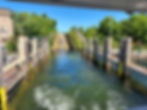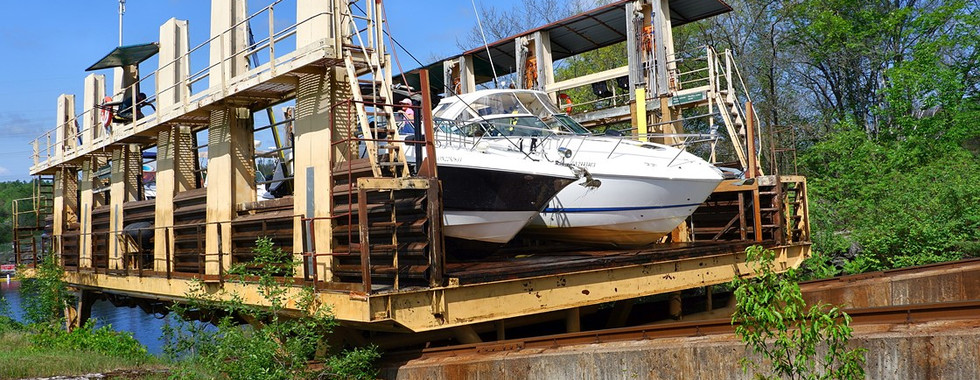Ride The Rails - Canada's Big Chute Marine Railway
- BoatBlurb Contributor
- 6 hours ago
- 4 min read
The Big Chute Marine Railway is inarguably one of Canada's greatest marine engineering achievements. It was created out of necessity, improved upon through ingenuity, and maintained through environmental awareness and practicality. It's a unique experience unlike anything recreational boaters will find around the world. If it isn't on your boating bucket list, it should be.
Big Chute Marine Railway is located on the Trent–Severn Waterway, a 386-kilometer meandering waterway that connects Lake Ontario and Georgian Bay, in the heart of Port Severn, Ontario. Cruiser owners doing the Great Loop or traveling the vast Great Lakes system use this waterway as a cornerstone of the region, which serves as a crucial link in Ontario's complex boating network. For well over a century, the area has become a haven for both long-distance traveler and local boaters looking for a distinctive experience while navigating through Lake Huron, Georgian Bay, Lake Simcoe, and onward toward Lake Ontario without ever leaving the province.
Before highways and cottage-country tourism, the waterways surrounding the Severn River were used for logging, transportation, and settlement. These early industries were heavily dependent on the river routes to get needed supplies to needed locales. The Trent–Severn Waterway was, and still is, a picturesque meandering network of lakes, rivers, and channels carved through the granite and pines of the Canadian Shield. By the time boating became a popular pastime in the early 20th century, the most challenging engineering problem was at its western end, where the waterway meets Georgian Bay. The Severn River plunges precipitously through rough terrain near Big Chute, forming a striking barrier that made a traditional lock system expensive, difficult, and possibly hazardous to implement.
Originally, engineers in the early 1900s intended to use several conventional locks to address the terrain issue, but the First World War and shifting federal budgets compelled a different strategy. A wooden single-track marine railway was established in 1917 as a temporary fix. Its purpose was to raise small boats out of the water, transport them over the hill on a rail-guided cradle, and then safely lower them on the other side. The idea was straightforward, effective, and efficient. What started as a temporary solution turned into a waterway innovation. A larger carriage was added to the system in 1923 to accommodate the increasing size and quantity of vessels using the Trent–Severn route as boating grew increasingly popular.
By the 1960s, it was evident the wooden system was unable to keep up with the region's growing popularity among boaters. The Big Chute Marine Railway was redesigned by the federal government and finished in 1978. With the addition of a dual-track steel carriage, the updated design could lift boats up to 100 feet long and 100 tons in weight. The secret to its capability is a dual-track arrangement: slings automatically adapt to the hull shape of each vessel, and rails maintain the platform level as the carriage climbs the hill and descends again. Boats stay steady the entire way, hanging safely over the land before being gently lowered back into the water.

As you might expect, the Big Chute experience leaves a lasting impression. The marine railway is more like a ride than a traditional lock, where the sensation is just rising or falling with the water level. Parks Canada operators secure your vessel with slings as you ease forward into the cradle. After a few moments, the water beneath you recedes as the railway begins to climb, and your boat, which is kept stable and level within the slings, begins traveling in the air. You can gaze down from the deck at the rocky shoreline below and people taking pictures from the nearby platforms. After a few minutes, your boat will roll over the hilltop on the rails and begin heading down the other side toward the channel. It's a unique chance to take in an elevated vista while aboard a vessel that is otherwise kept at water level.
It's easy to plan a trip through Big Chute, but there are a few things to keep in mind to make sure it goes smoothly. Parks Canada posts the dates and hours of operation every year. The season runs from late spring to early fall. Boaters heading to the location should expect to wait in line on summer weekends, particularly during the busiest months of July and August. Verifying your vessel's dimensions beforehand is a good idea, especially if you operate a boat with a wide beam or unique hull shape.
The process itself is straightforward: follow the instructions of the staff when you approach, carefully line up in the carriage, and stay on board the entire time. The Parks Canada staff will give you directions as needed. When followed correctly, traveling through Big Chute is often faster than some of the Trent-Severn's larger locks because it is mechanical rather than water-level dependent.
Boaters can combine their Big Chute transit with a laid-back cottage-country itinerary thanks to the marinas, food stops, and overnight mooring options available in nearby communities like Port Severn and Coldwater. A lot of cruiser boaters spend the entire day there, or even longer, taking advantage of the picnic spaces, strolling the visitor platforms, or staying to watch other boaters go through their lift. Even people who aren't boaters drive to see it in action.
More than a century after its first carriage pulled a boat over the hill, the Big Chute Marine Railway is still in use, still incredibly popular, and a unique that boaters won't find anywhere else in the world. It's design and function was a direct result of inventiveness demanded by geography, refined by necessity, and conserved for utilitarian, historical, and cultural reasons. A trip through Big Chute should absolutely be on your boating bucket list. #destinations #culture


























